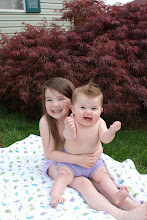Below is a list of the common types of cloth diapers and covers that are available. This is just a list and is not necessarily in any particular order. I will give you more information on cloth diaper accessories, general terms and my personal favorites at a later time. This is not meant to overwhelm you, but just to inform you of your options. Please email me or reply to this post if you have any questions.
Prefold: A flat, layered rectangular diaper with extra layers in the center for added absorbency where it is needed most. Most are either 4x6x4 or 4x8x4 and are made of 100%cotton in either a Birdseye weave or twill. They come in bleached (white) or unbleached (natural colored). Unbleached cotton contains natural oils and will need to be washed several times before use to remove the oils and make them absorbent. Diaper service quality prefolds (DSQ) are usually from China or India. These are superior to any prefolds that you can buy at a retail chain store as these usually have a polyester center (not very absorbent). Commonly used with a fastener and waterproof cover. Or can be trifolded in a snug fitting diaper cover. Prefolds are one of the most economical diapers.
Flat: A single layer cotton fabric square that can be folded where absorbency is needed most, or folded into a rectangle and used like a prefold. Economical and one sized. This diaper can work from birth to potty training. Must be held together with pins or a Snappi. Waterproof cover is needed
Fitted: A shaped diaper that includes elasticized legs and waist. Most commonly has a hook and loop or snap closure. This diaper is more expensive than a prefold but is better at containing explosive poo. A diaper cover is needed to make this waterproof. Fitted diapers can be made from a variety of fabrics such as cotton, hemp or bamboo.
Pre-Fitted: A fitted diaper that has been made from a prefold. May have snaps or hook and loop closure, or require pins or a Snappi. You need a cover to make this type of diaper waterproof.
Contour: Shaped, like a fitted diaper, but without elastic and usually without attached closures. Commonly used with pins or a Snappi. You need a cover to make this type of diaper waterproof.
Pocket Diaper: A diaper with two layers sew together with a “pocket” opening in the back of the diaper. This diaper requires the addition of an absorbent insert. The outer layer is most commonly made of Polyurethane Laminate (PUL), with the inner (the part that sits against baby's skin) being a "stay-dry" fabric (micro fleece, or suede cloth,) that allows moisture to seep through to the insert, keeping baby's skin dry. This diaper needs to be washed after each use. No extra waterproof cover is needed.
All-in-one Diapers (AIO)
All-in-ones are fitted diapers that have an outer waterproof layer built-in and don’t require a separate cover. AIOs are a convenient diaper for quick and easy changes for daycare or on outings. They are most like a disposable and also the most expensive.
All In Two (AI2): Similar to an AIO, but with a removable absorbent layer for easier washing and faster drying. Absorbent layer is usually snapped in place inside the diaper, sitting directly against baby's skin. You do NOT need a cover to make this type of diaper waterproof.
Diaper Covers
Cloth diaper covers come in all shapes, colors, fabrics and sizes. They are used over a cloth diaper to keep baby's clothes dry. Diaper covers are shaped to fit over a fitted or prefold diaper and fasten with snaps or hook & loop or pull on without fasteners. Covers can be made of nylon, PUL, polyester, treated cotton, wool or fleece.
Polyurethane Laminate (PUL): The waterproof fabric commonly used for diaper covers. These can be reused for several changes before washing, unless soiled with poo. This can be make into wrap style diaper covers that close with hook and loop or snaps.
Nylon: Another waterproof and breathable choice for diaper covers. Most commonly used to make pull on style diaper covers. Very economical.
Wool: Wool yarn can be used to knit or crochet diaper covers or long pants (longies) that, once treated with lanolin, are quite waterproof. Wool fabric (felted wool or knit wool fabric) or recycled wool sweaters can also be used to make soakers or longies. Wool covers also offer breathability that PUL covers do not. Wool can be used many times before washing is needed, unless it has become soiled. Just air dry between uses. Most wool requires gentle hand washing, but some wool can be machine washed. MORE ON WOOL LATER
Polyester Fleece: A synthetic alternative to wool, fleece can be treated with fabric softener for water resistance and used as a diaper cover. Fleece needs to be washed more frequently, but can be washed with regular clothes.
Plastic Pants
Plastic pants were commonly used in the 50s – 70s and are still available from Gerber. They are made of vinyl, a material that releases dioxins when warmed and can crack and degrade with regular washing/drying. They are not the best choice, but are economical and waterproof. Vinyl does not allow air circulation so rashes can be a problem if vinyl covers are used exclusively.
Saturday, October 17, 2009
Subscribe to:
Post Comments (Atom)




GREAT blog! I clicked over from DS and am GLAD I DID! (((((HUGS))))) sandi
ReplyDelete